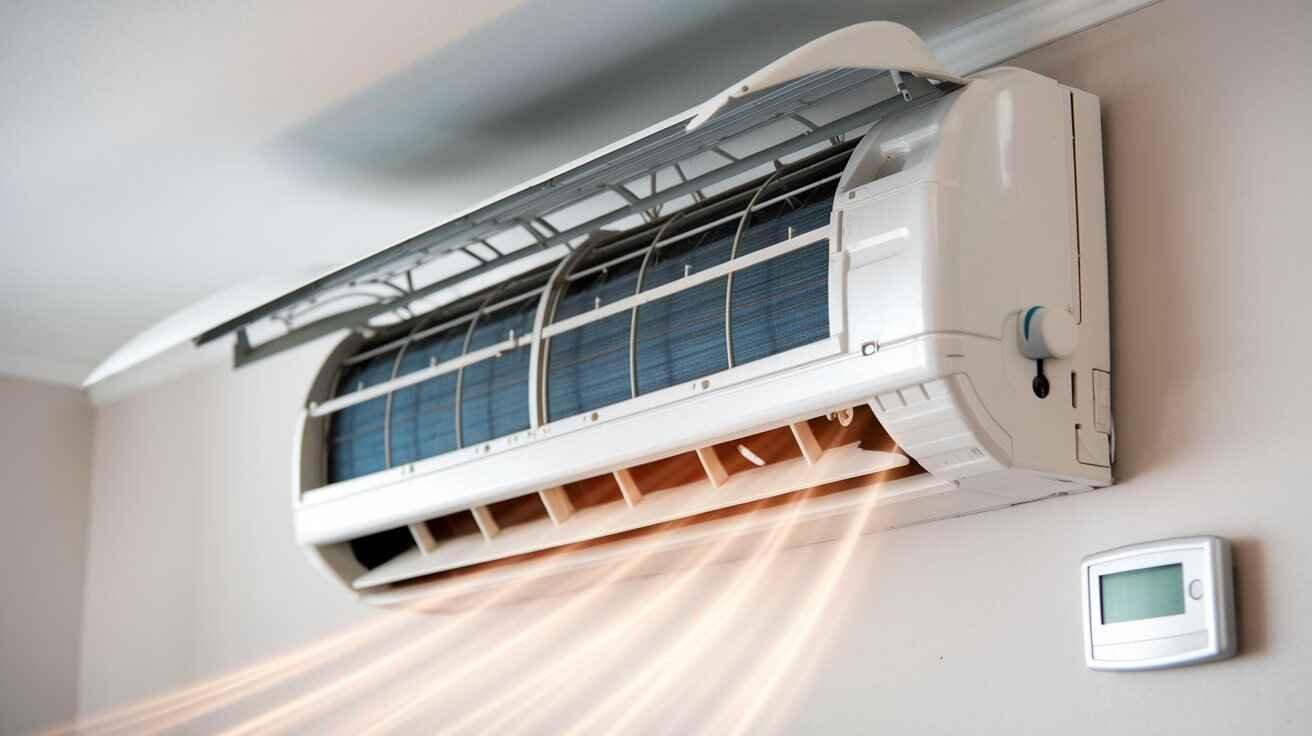If you’ve noticed that your air conditioner not blowing cold air but running, it can be a frustrating experience, especially during hot weather. While the sound of the AC running might suggest that it’s operating normally, if the air coming out of the vents is warm or only slightly cool, the situation is far from ideal. A functioning air conditioner should blow cool air to maintain comfort inside your home. However, various factors could be behind this issue, and understanding the causes can help you find a solution.
This guide will walk you through the common reasons why your AC might not be blowing cold air, provide helpful insights on what could be causing it, and offer solutions to resolve the problem effectively. By understanding how air conditioners work and diagnosing potential issues, you can get your cooling system back to full efficiency.
How Does an Air Conditioning System Work?
To efficiently troubleshoot your air conditioner’s problems, you must first understand how an air conditioning system operates. Air conditioners are designed to cool and dehumidify the air in your private home. They accomplish that by transferring warmness from the indoor environment to the outside, using a technique involving refrigerants, coils, and a blower fan. When working nicely, an AC machine absorbs the heat from the air within the home and expels it outside, cooling the indoors.
The critical components of the machine that make this work encompass:
- Evaporator Coil: This coil absorbs heat from the air in your house. It incorporates refrigerant that evaporates because it absorbs the warmth.
- Condenser Coil: This coil is positioned outside the home and releases the heat absorbed using the refrigerant to the outside air.
- Compressor: The compressor pressurizes the refrigerant and circulates it through the gadget.
- Blower Fan: The fan blows the cool air into the rooms through the air ducts, ensuring regular airflow.
When these components fail to operate well, the AC can continue strolling but fail to chill the space efficiently.
5 Reasons Why Air Conditioner Not Blowing Cold Air But Running
Low or Leaking Refrigerant
One of the most common reasons an air conditioner would possibly prevent blowing cold air is low refrigerant levels or a refrigerant leak. Refrigerant is the substance that cools the air on your AC machine by absorbing warmness from the indoor air. If the refrigerant level drops below the desired amount, the cooling process is disrupted.
Why It Happens
Refrigerant doesn’t simply disappear over the years; it leaks out of the gadget due to damage to the refrigerant lines or connections. The leak can be small and not at once substantive, but over time, it results in low refrigerant degrees. This can cause bad cooling performance because the machine can’t take in or release warmth as effectively as it should.
Signs to Look For
- Warm Air: One of the most common symptoms of a refrigerant leak is heat or room-temperature air blowing from the vents.
- Ice Buildup: A frozen evaporator coil or refrigerant line, often caused by low refrigerant levels, may indicate this issue.
- Longer AC Run Time: If your AC runs longer than normal and the temperature doesn’t drop, it may be due to low refrigerant.
How to Fix It
- Professional Refrigerant Recharge: If you notice that the refrigerant is low or leaking, contact an HVAC technician. They will inspect the system for leaks and fill the refrigerant to the proper degree.
- Seal Leaks: The technician may even repair any leaks observed in the refrigerant line. This is critical because sincerely refilling the refrigerant without fixing the leak will lead to an equal problem inside the Destiny.
Refrigerant issues are usually handled by professionals because they require unique equipment and understanding to ensure the gadget is charged effectively and correctly.
Also Checkout: Mac Mini M3: Release Date, Features, and Performance Expectations in 2024
Dirty or Clogged Air Filter
The air clear out to your air conditioning gadget is vital in retaining airflow and enhancing the system’s performance. Over time, dirt, dust, and other debris can accumulate at the clearout, leading to clogs that reduce airflow and make it hard for the AC to chill the air efficiently.
Why It Happens
As your AC operates, the air filter captures dust, pet dander, pollen, and other contaminants to prevent them from circulating throughout your home. If the clearout turns too dirty or clogged, the airflow might be constrained, making it harder for the device to chill the air.
Signs to Look For
- Weak Airflow: If you notice vulnerability or reduced airflow from the vents, it’s probably due to a clogged air filter.
- Uneven Cooling: In a few cases, rooms may experience hotter than others, indicating that the air isn’t always being circulated nicely because of restrained airflow.
- AC Runs Continuously: The device may also hold walking without reaching the preferred temperature, as the AC struggles to preserve proper airflow.
How to Fix It
- Clean or Replace the Filter: Check the air clear out month-to-month, mainly during the top cooling season. If it’s clogged, clean it (if it is reusable) or update it with a brand-new one. Typically, filters need to be changed every 1–3 months.
- Use High-Efficiency Filters: If you live in a dusty environment or have pets, recall using a high-performance particulate air (HEPA) filter. This type of filter captures finer debris and might significantly improve airflow and air quality.
Regularly changing or cleaning the air filter not only improves cooling performance but also contributes to higher indoor air quality and can increase the life of your air conditioner.

Thermostat Issues
Your thermostat is the brain of the air conditioner. It monitors the temperature in your house and sends indicators to the AC unit to cool or hold the temperature. If the thermostat malfunctions, it can incorrectly signal the device to run without cooling the air.
Why It Happens
Thermostats can become defective over the years because of electric troubles, dirt buildup, or wiring issues. Additionally, settings may also be inadvertently modified, causing your AC to run inappropriately.
Signs to Look For
- Incorrect Temperature Readings: If the thermostat displays a temperature that does not fit the room’s real temperature, there’s probably trouble.
- AC Won’t Turn Off or On A malfunctioning thermostat can prevent your air conditioner from turning off when it ought to, or it may not signal the gadget to start cooling.
- Temperature Fluctuations: If your AC is walking, however, the temperature will keep fluctuating, and the thermostat will not be working as it should.
How to Fix It
- Check the Settings: Ensure the thermostat is ready to “Cool” mode and the temperature is lower than the room’s temperature. Sometimes, it’s as simple as changing the setting.
- Recalibrate or Replace the Thermostat: If the thermostat isn’t always reading appropriately, attempt recalibrating it. If it’s an older version or still defective, don’t forget to replace it with a brand new, programmable, or smart thermostat for higher manipulation.
A nicely functioning thermostat guarantees your AC runs efficiently and cools your private home to keep up with your wishes.
Blocked or Clogged Condenser Unit
The condenser unit, positioned outside your property, is responsible for expelling the heat absorbed via the refrigerant. If it is blocked or clogged, it cannot successfully launch the heat, causing the system to work less efficiently and saving you bloodless air from circulating the interior.
Why It Happens
The door condenser unit is exposed to factors and particles that can gather around, including leaves, twigs, dust, and grass. Additionally, the gadget will try to expel warmth nicely if the coils become grimy.
Signs to Look For
- Warm Air: If your AC blows warm air and you observe that the condenser unit feels unusually warm, it can be blocked or clogged.
- Visible Debris: You may also see debris accumulation around the outside unit.
- Poor Cooling Efficiency: The AC runs, but rooms are no longer cool, indicating negative heat dissipation from the condenser unit.
How to Fix It
- Clear the Area Around the Condenser: Remove any particles, including leaves, grass, or trash, across the unit to ensure the right airflow.
- Clean the Condenser Coils: Use a garden hose to gently spray the coils (without damaging them) to remove dirt buildup. If dirt is mainly present, you may additionally need to use a coil cleanser.
- Straighten Bent Fins: If the condenser fins are bent, straighten them using a fin comb to allow better airflow.
Regular cleaning and upkeep of the condenser unit help improve cooling performance and prevent long-term damage to your gadget.
Frozen Evaporator Coil
The evaporator coil is responsible for absorbing heat from the air inside your property. However, if the evaporator coil freezes, it will not be able to absorb heat efficiently, leading to heat air blowing from your vents.
Why It Happens
Several factors can motivate the evaporator coil to freeze:
- Low Refrigerant: If refrigerant degrees are low, the coil cannot maintain the appropriate temperature, causing it to freeze.
- Poor Airflow: Dirty filters or blocked vents can reduce airflow, causing the coil to freeze.
- High Humidity: Excess moisture in the air can also cause freezing, as the coil struggles to dehumidify the air.
Signs to Look For
- Ice Buildup: Observing ice on the evaporator coils or refrigerant strains signals that the coils are frozen.
- Weak or Warm Air: The airflow from the vents could be weak or warm because the coil isn’t soaking up warmth nicely.
How to Fix It
- Turn Off the AC and Allow it to Thaw: Shut off the AC unit and let the coil thaw completely. This might also take numerous hours.
- Clean the Coils and Check for Airflow Obstructions: After the coils thaw, smooth any dust or particles on them. Then, check the air clearout and vents to ensure proper airflow.
- Fix Refrigerant Leaks: If low refrigerant tiers are the issue, name a technician to fix the leak and recharge the machine.
Regular preservation and ensuring the AC has proper airflow can prevent your coils from freezing and keep your system running smoothly.
How Electrical Issues Affect Cooling
Electrical issues are not an unusual reason for poor AC overall performance. Here’s how these problems impact cooling:
- Faulty Wiring: Damaged or unfastened wiring reduces electricity delivery to key additives, affecting performance or causing the unit to close.
- Capacitor Failure: The capacitor powers crucial features like starting the compressor or fan. When it fails, the AC won’t run nicely.
- Tripped Circuit Breakers: Electrical overloads can experience breakers, totally reducing power to the gadget.
- Power Surges: Sudden voltage spikes can harm vital components, such asressor or control boards.
Key Takeaways
- Regularly look into wiring for wear and replace broken parts promptly.
- Use surge protectors to safeguard sensitive components.
- Address tripped breakers by identifying and resolving the underlying purpose.
Diagnosing the Problem at Home
Before calling an expert, try those easy diagnostic steps:
- Check the Thermostat: Ensure it’s set to “cool” and adjust the temperature to check functionality.
- Inspect Power Sources: Confirm that the AC is properly plugged in and the strength delivered is energetic.
- Examine the Circuit Breaker: Look for a tripped breaker and reset it if wanted.
- Look for Warning Signs: Burning smells, flickering lights, or humming noises may additionally sign electrical problems.
Key Takeaways
- Resetting the breaker can provide a brief restore. However, habitual journeys require expert attention.
- Cleaning across the thermostat guarantees accurate temperature readings.
- Always flip off the energy delivered earlier than when examining electrical connections.

When to Call an HVAC Professional
While minor fixes may be treated at home, a few conditions call for expert intervention:
- Recurring Electrical Problems: Frequent tripping of breakers or non-functional capacitors.
- Visible Damage: Burnt wires, melted additives, or scorched stores.
- Complete Shutdowns: If the AC fails to restart or cool, notwithstanding troubleshooting.
Key Takeaways
- Professionals have specialized gear to investigate internal additives like capacitors, compressors, and manipulate boards.
- Attempting advanced electrical repairs without knowledge can worsen the problem or pose safety risks.
The Cost of AC Repairs
Repair fees vary depending on the complexity of the issue:
- Capacitor Replacement: Typically expenses $a hundred and fifty–$four hundred.
- Rewiring Services: Expenses range from $two hundred–$500, depending on damage.
- Compressor Repairs: Among the most costly, costing $1, two hundred–$2,500.
Key Takeaways
- Regular renovation reduces the likelihood of highly-priced repairs.
- Check producer warranties or carrier contracts to offset charges.
- Compare rates from HVAC experts to ensure fair pricing.
Tips for Maintaining Your Air Conditioner
Preventive protection is an exceptional way to avoid electrical problems. Here’s how:
- Clean or Replace Filters: Dirty filters block airflow and strain the device, increasing the likelihood of electrical faults.
- Inspect Wiring: Periodically check for frayed or free wires to prevent strength disruptions.
- Use Surge Protectors: These gadgets shield in opposition to voltage spikes, extending your AC’s lifespan.
- Schedule Regular Tune-Ups: Professional inspections assist in picking out and fixing troubles early.
Key Takeaways
- Clean filters every 1–three months for top-quality overall performance.
- Regular professional servicing keeps your machine green and secure.
Signs It’s Time to Replace Your AC
Sometimes, maintenance isn’t sufficient, and an alternative turns into important:
- Frequent Breakdowns: Ongoing restoration fees can outweigh the advantages of keeping an older unit.
- Age of the Unit: Most AC structures have a lifespan of 10–15 years, after which they lose performance.
- Increased Energy Bills: Older or faulty structures devour greater power, using up utility prices.
Key Takeaways
- Replacing an old AC with an electricity-efficient version can keep on payments and repair costs.
- Consult HVAC professionals for recommendations on selecting the proper gadget for your home.
Conclusion
Suppose your air conditioner is running but now not blowing bloodless air. In that case, it’s crucial to become aware of the underlying trouble, whether or not it’s low refrigerant, a grimy air filter out, thermostat troubles, or electrical faults. Timely protection, cleaning filters, analyzing components, and scheduling normal track-ups can save you lots of these troubles. For complex problems, seeking expert HVAC help guarantees secure and effective repairs. Addressing these concerns immediately could repair your AC’s overall performance and keep a snug indoor environment.
FAQs
What causes electrical issues in air conditioners?
Electrical troubles often stem from faulty wiring, capacitor failure, circuit breaker problems, or strength surges.
How can I prevent frequent electrical issues in my AC?
Regular maintenance, putting in surge protectors, and timely professional inspections can save you maximum electrical issues.
When do I have to replace my air conditioner?
Replace your AC if it’s over 10–15 years old, requires frequent repairs, or requires extensive better strength payments.
What is the common fee for repairing an AC with electric troubles?
The costs vary with difficulty, starting at $100-150 for minor fixes like capacitor replacement and $2,500 for major maintenance like compressor troubles.
Why does my AC preserve tripping the circuit breaker?
This can be caused by an overloaded circuit, a failing compressor, or wiring issues. A professional evaluation is usually recommended.
Also Read: 10 Best Laptops for College Students: Power Up Your Academic Journey!





